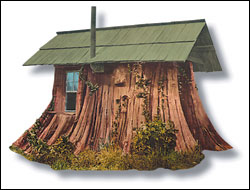MY NOMINEE FOR Best Off-the-Radar-Screen Initiative is the development of a city forest management plan now being crafted as part of Mayor Greg Nickels’ green agenda. In the next few weeks, the city will receive some new, laser radar (LIDAR) satellite data that will help generate a three-dimensional picture of our city’s green areas and how they’re doing.
Why does a city of concrete need a forest plan? Seattle has an estimated 1.2 million trees, and the canopy of that “forest” covers some 25 percent of the citynot untypical given our size. Still, being typical is not what you’d expect of an environmentally conscious city built in the middle of a vast forest.
On the other hand, the first thing our founders did after landing was put up a sawmill, so we shouldn’t be surprised if we’re a bit naked. Nevertheless, it’s understood that trees improve the health of a city. Not only do they prettify a place, they clean the air, reduce noise, improve water quality, and prevent runoff and erosion. The value of these functions alone is roughly estimated by the city at more than $1 billion per year. It’s probably much more. In aesthetic, spiritual, romantic, and recreational terms, it’s incalculable.
But getting a handle on what’s happening with our trees and habitats isn’t easy. To my eye, parts of Seattle seem much greener than when I was growing upstretches of Rainier Avenue South evoke a tree-lined boulevard, and some avenues have “Olmsteded” nicely, in keeping with the vision of our turn-of-the-century planners. Even buzz-cut Ballard, which was cleared by Mossback’s ax-wielding Scandinavian kinfolkpeople who saw trees as a challenging grass to be mowedseems to be sprouting more leaves of late.
THE OLD GROWTH IS mostly gone, though some survives in pockets. The most impressive is in Seward Park, the city’s biggest and oldest stand of original coniferous forest. The city’s forester, Mark Mead, says there are trees in the park more than 200 feet tall (the LIDAR data will be more exact), and he estimates some could be as old as 600 years. They include the city’s biggest Doug fir and some impressive cedars. The whole ecosystem, small and isolated, is essentially intact. What was once an island in Lake Washington is now an oasis of ancient memory in an increasingly urbanized terrain.
Old growth was still being cut in Seattle (Carkeek Park) as late as the 1940s, partly due to World War II timber shortages. Despite aggressive neighborhood planting, trees and urban wildlife habitat are still being lost to development. A consequence of density and infill is that we’ve been building in greenbelts and vacant lots, and the size of yards is shrinking. It would be convenient to blame chain saw-crazy judges for our vanishing trees, but development is the main culprit.
It’s hard to mitigate those changes on the fly. As older trees are cut, thousands of young ones are planted, but the loss of older trees has an impact. Fewer trees are capable of hosting an eagle’s nest, for example. Fast-growing parking-strip saplings don’t make up for the loss of mature trees reaching the natural end of their life cycles, any more than tree farms can replace old growth. Maintaining and nurturing an urban forest requires information, management, patience, and a plan. It also requires cooperation between city departments and from private-property owners. The city is working to develop a forest management plan to keep our trees healthy and to identify and improve key habitats. It will also help steer development.
URBAN FOREST HEALTH goes beyond the city limits. While no one I talked to is sure how the city’s forest is doing overall, it’s dead certain that the forest of the metro region has shrunk. Suburban sprawl is chomping away, like an infestation of caterpillars. Yet the health of these lands is important to the quality of life in Seattle. Our city’s official bird, proclaimed by the City Council last March, is the great blue heron. Many of these birds nest and breed on the Black River in Renton, according to Alex Morgan, conservation coordinator for Seattle Audubon. If we want to keep heron healthy and happy in Seattle, we need to keep them safe on the Black River, too.
Dennis Paulson, director of the Slater Museum of Natural History at the University of Puget Sound, is an avid Audubon birder. He’s been counting birds in Seattle for 35 years. When he first moved to his current home 11 years ago, he said, he did all the things you’re supposed to do to make it more bird-friendly: install feeders, dig ponds, plant trees. Sadly, he’s concluded that it hasn’t made a bit of difference. What’s happening in the larger region matters even more.
While the city’s forest plan won’t address regional problems per se, it will help us better understand our piece of the ecological puzzle. The new satellite data can inform city planning and yield a detailed inventory of our green spaces. That will provide the basis for knowing better how our policies affect the quality of life for everyone in Seattle, including trees, frogs, eagles, robins, otters, and beavers. They don’t get to vote, but the mayor has rightly recognized an important constituency.







